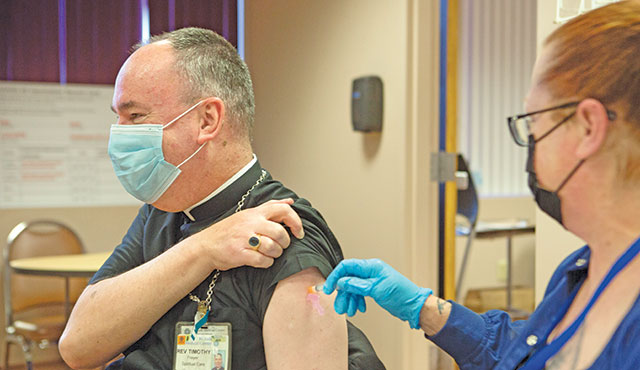Despite hiccups with supply shortages, delivery delays and the online registration system, the first doses of vaccines to fight the deadly COVID-19 virus are being rolled out and “…into arms” of Orange County parishioners and residents, according to health officials.
With the federal government promising a massive ramp up of production and distribution, there is hope of a rapid uptick of vaccinations.
Recently California ranked an abysmal 46th in the U.S. in administration of vaccines received, at 46.5 percent, according to the CDC Data Tracker.
The Diocese of Orange has rallied to encourage parishioners to take the vaccines when they become available and it has been working with the Orange County Health Care Agency to accomplish that.
“We want to make sure we get information and awareness out there,” said Armando Cervantes, director of Hispanic Ministry for the Diocese.
Through a phased approach, Orange County started vaccinating its most vulnerable and critical populations: health care workers, seniors 65-older and law enforcement.
Subsequent phases will be by priority for occupation, such as education and childcare workers, and underlying conditions, before vaccines are generally available.
Health officials say it is important for those in different categories to wait until they are eligible. Information is available at occovid19.ochealthinfo.com.
As Jennifer Dagarag RN, faith community nurse with St. Ireneus Church in Cypress said, “With the vaccine rolling out, the key will be patience.”
Orange County Supervisor Doug Chafee echoes the call for patience.
“We’re working to make sure (vaccines) get in the right arms at the right times,” he said. “This is a long-term process.”
Registration and appointments for the county are handled online. Residents and workers in Orange County are eligible and can register at www.Othena.com.
Once residents register, Othena sends notifications and schedules follow-up shots.
Despite Othena’s bugs, Dagarag said, “I think it’s a good tool; it’s just overwhelmed. It’s just the demand, and we want it all at once.”
On Jan. 13, Orange County opened its first large vaccine site at Disneyland and a second 10 days later. The county is prepared to open up to five large distribution centers overall that can each deliver 3,000 or more vaccines a day.
However, the County needs to receive the vaccines from the state and in the early going availability was a sticking point.
“We can only use the vaccine available. Every dose is being shot into arms as quickly as possible,” said Lisa Bartlett, fifth district supervisor.
As of Jan. 25, more than 118,000 first doses had been administered in Orange County and more than 29,000 second doses.
On Jan. 23, Dr. Clayton Chau, director of the Orange County Health Care Agency, said the county had 66,000 vials of vaccine but more than 600,000 residents in its top tier.
Meanwhile, the Diocese is also at work trying to allay fears that range from conspiracies theories to fear of harmful or even deadly vaccine side-effects. Among Latino residents there is also worry that information provided could make them targets for deportation.
“We want to dispel any myths that are out there,” Cervantes said.
Another looming issue for the diocese is getting information to communities that lack access to information, including those with language barriers or lack of internet access or technical proficiency.
The Diocese is working with Latino groups, parishes and centers to distribute information as widely as possible as well as Catholic health care ministries and Catholic Charities.
“We need more community partners to get the vaccine into communities affected and marginalized,” Dagarag said.
According to the Health Care Agency, whites at 38 percent have received vaccines at more than triple the rate of Latinos at 11 percent. Asians account for 30 percent of vaccines.
Chau said the Health Agency has contacted about 25 senior centers to reach hard-to-cover populations, but clearly work needs to be done. Only 15 percent of residents 75-older have been vaccinated.
Meanwhile, church leaders from parishes to the Vatican agree that vaccines are morally acceptable, safe and effective.
Controversy arose because of the use of fetal stem cell lines in testing.
Auxiliary Bishop Timothy Freyer has been front and center in the Diocese’s efforts to promote vaccines. He recently spoke on OC Catholic Radio, where he said, “As Catholics we’re morally able to take those vaccines.”
Bishop Freyer received his first dose of the vaccine on Jan. 22 at St. Jude Medical Center in Fullerton. Bishop Kevin Vann received his on Jan. 26 at St. Joseph Hospital in Orange.
County officials have set July 4 as a target date to deliver vaccines to all of the 3.2 million O.C. residents, including Orange County’s 1.3 million Catholics, who want them.
Of the size and scope of the vaccination effort overall, Dagarag said, “That’s really unheard of in modern history. But I think it’s coming.”
LEARN MORE
To see who is eligible for vaccines, visit the OC Health Care Agency’s website: occovid19.ochealthinfo.com/phased-approach-vaccine-distribution.
For questions related to COVID-19, visit www.ochealthinfo.com/novelcoronavirus.
For those without internet access, there is a COVID-19 HOTLINE in English and Spanish (714) 834-2000; Medical questions: Health Referral Line (800) 564-8448.
Spanish language information is also available from at (714) 542-7792 and latinohealthaccess.org.

